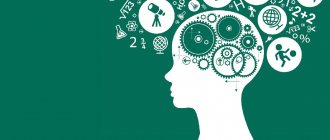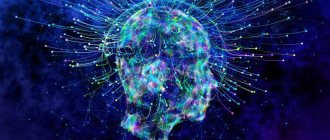Mental processes are one of the most complex, diverse in their manifestations and least studied in the human body. The table presented in this article clearly divides the phenomena occurring in our psyche into three main groups: by properties, states and processes. All this is a reflection of reality, which can be traced in dynamics, that is, each such phenomenon has its beginning, develops and ends with the resulting reaction. Mental processes (the table clearly demonstrates this) interact extremely closely with each other. Mental activity continuously flows from one process to another when a person is awake.
Mental conditions
Processes occurring in the human psyche can be caused by external influences that irritate the nervous system, and can also be born directly in the internal environment of the body, depending on the state in which it is at that moment. The table divides mental processes into three main groups: cognitive, emotional and volitional. Here their components are classified in detail: perception and sensations, memory and representation, imagination and thinking belong to cognitive processes, and active and passive experiences belong to emotional ones. The table reveals volitional mental processes as the ability to make decisions, execution and volitional effort.
Let's take a closer look at the column that represents the state of the human psyche. The table represents motivational, that is, cognitive mental processes most widely, up to the actualization of needs. The reasons are clear: they are the ones who can ensure correct human activity, help form knowledge and regulate behavior. Various cognitive mental processes merge into a single stream of consciousness, a table of which is presented in the article, since a person is a very complex organism, and the mental component is the basis for any life activity. It is she who ensures adequacy in reflecting reality, controlling all types of human activities.
Attention and memory
The process of cognition can be represented as a ladder, the ascent along which begins with sensations, then moves on to perception, thinking, imagination and ends at the top, which is creativity. But two cognitive processes stand apart. This is attention and memory. They play an auxiliary role and exist only in connection with other cognitive processes. But on the other hand, no intelligent human activity is possible without them.
Attention
This is the concentration of consciousness on external objects and phenomena or on internal processes. In order to perceive something, we must focus on it, and objects that do not fall into the sphere of attention are simply not noticed by us, that is, they are not included in the process of cognition.
There are two main types of attention: voluntary and involuntary.
- Involuntary attention occurs on its own, under the influence of specific stimuli. Such concentration, regardless of our desire, is caused by some strong, bright, unusual objects and phenomena, or those that matter to us and are associated with our interests and needs.
- Voluntary attention is a conscious activity aimed at maintaining concentration on objects that do not arouse interest. The significance of these objects is determined by the goals and objectives of the activity, and not by their brightness and unusualness. For example, to concentrate on a complex textbook text, you need to make an effort. Voluntary attention is often difficult, so it is necessary to develop conscious concentration skills.
In psychology, attention is considered both as a dynamic side of cognition and as its guide. It is this process that determines the selectivity of our consciousness, not only in terms of cognition, but also in mental activity in general. Attention is also associated with increased activity in various centers of the brain and makes any of our activities, including cognitive ones, effective and productive. And the loss of the ability to concentrate and concentrate, the involuntary loss of attention is a serious mental illness.
Activity level
The fact that the processes of the human psyche proceed unevenly, with different intensity and speed, is shown by the very first tables on general psychology. Mental processes depend entirely on the state of the individual and external influences on it. What is a mental state? Roughly speaking, this is the relative stability of the level of mental activity, which manifests itself in decreased or increased activity. A person can experience a wide variety of conditions. Anyone can remember that sometimes physical and mental work seemed easy and was productive, and at other times the same actions required a lot of work and still did not achieve the desired effect.
Depending on the state of the individual, the characteristics of mental processes also change; the table clearly shows this. The nature of the processes occurring in the psyche is reflexive; they arise and change depending on physiological factors, the environment, the progress of work, even on verbal influences (from praise and blame, the state of the individual clearly acquires new qualities). The comparison table breaks down the mental cognitive processes of an individual point by point. It contains the most studied factors of such changes. For example, the level of attention can fluctuate from concentration to distraction, characterizing the general mental state, and emotional moods especially clearly change the general background of all characteristics - from sadness or irritability to cheerfulness and enthusiasm. Especially a lot of research concerns the main creative state of the individual - inspiration.
Personality traits
Mental properties of a person are stable formations, the highest regulators of activity, which determine the level of the state in the quality and quantity of its components, which is observed in the behavior and activities typical of a particular person. A comparative table of mental cognitive processes connects each gradually formed property of the psyche with the result of practical and reflective activity. The variety of such properties is quite difficult to classify, even in accordance with the basics of all already grouped mental processes.
However, the intellectual, that is, cognitive, volitional and emotional activities of the individual have been studied quite deeply and considered in many complex interactions of their synthesis. Thus, the table shows a variety of mental processes. The properties, functions and role of these components in human life will be considered by us within the framework of this material. Of the cognitive functions, for example, it is worth noting observation and a flexible mind; volitional functions include persistence and determination, and emotional functions include sensitivity and passion. The properties and functions of mental processes differ, but they all play an important role in our daily lives.
Content
- Mental processes
- Mental properties
- Mental conditions
This section is studied from the 1st year of the Faculty of Psychology, since the knowledge acquired in this subject is the basis for studying further material in all sections of psychology. The results of research in the field of general psychology are also the basis for the development of all branches and sections of psychological science.
General psychology studies cognitive processes, patterns and properties of the psyche, manifestations of various mental phenomena, various theories and concepts of outstanding psychologists, and forms concepts and terms.
The subject of general psychology is mental phenomena, i.e. mental processes, mental properties, mental states.
Mental phenomena are a general psychological category that includes various manifestations of the psyche that are closely interrelated and interdependent.
Synthesis
The properties of the human psyche do not exist separately; they act in synthesis, forming complex structural complexes. There is a classification of manifestations of the unconscious according to mental processes. A table of such states is presented below.
This includes the following processes that synthesize with each other:
- Life position: needs, interests, beliefs, ideals, personality activity and selectivity.
- Temperament is the natural properties of a person: balance, mobility, tone, other behavioral characteristics, everything that characterizes the dynamics of behavior.
- Abilities: a whole system of intellectual, volitional, emotional properties of a person that can determine creative possibilities.
- Character is a system of behavior and relationships.
Interconnected neuropsychic acts in their stable and purposeful totality have a certain scheme for transforming activity to obtain a certain result. These are the mental processes characteristic of each individual, which are of primary value for study. For example, memory as a mental process requires memorizing information; this is its need - conscious and unconscious. Here, the input to the process will be precisely this requirement as a property, and the output or final result will be the information remaining in memory.
Psychic phenomena
The most common mental processes were listed above, but let's look at these lists in more detail. They vary greatly among different authors. Common and noted by all are attention, emotions, memory, feelings, sensations, will, thinking, perception, speech. In the category of mental phenomena, they are accessible to any direct and unqualified observation.
Most often, what is interesting is not even the observed process itself, but its deviations from the norm, that is, its characteristics. Here, the usual table of features of mental processes usually helps students understand the classification. Children of all categories are studied especially carefully, but even their cognitive processes can be quite easily distinguished from emotional or volitional processes.
Personality Features
People are endowed with completely different capabilities: one is absent-minded, and the other is attentive, this one perfectly remembers faces, and the other only remembers melodies. In addition, behavior is characterized by any mental phenomenon and the degree of balance: some will be delighted by the surprise, some will be surprised, and some will be left indifferent. People treat each other differently: some love those around them, while others find humanity disgusting. There are people who are persistent, even stubborn in achieving their goals, and also those who do not care about anything - they always remain apathetic and lethargic.
Attitude to science
Russian psychology divides all mental phenomena into three types: properties, states and processes. The differences between them are not so great and are temporary. The processes usually take place quickly, but the properties are more stable and long-lasting. Modern psychologists believe that through the interconnectedness of mental processes, the psyche itself is formed, which can be divided into components only very conditionally, since there is no theoretical justification for this study. Nevertheless, not only major phenomena of the work of the psyche have been quite widely identified and studied, but also basic mental processes, for which there is far from a single comparative table.
But since psychology has become a science, scientists are developing methods for its knowledge, where the main postulate is an integrative approach to the human psyche, and all classifications in the tables are of propaedeutic and pedagogical value. Similar processes occur in society. Just as in the psyche of an individual, they are extremely interconnected in society: children study, parents raise them, work, athletes train, alcoholics drink, the police catch criminals, and so on. No matter how parallel these processes may seem, sooner or later they all intersect with each other in some way.
Sensory-perceptual sphere
This is the sphere of elementary cognitive processes, which include sensation and perception. On the one hand, they are the most ancient of all cognitive functions, on the other hand, they are the basis of knowledge of the world, as they ensure the entry of any information into the brain.
Feel
The various influences that the world has on a person are called signals; accordingly, the sense organs responsible for receiving these signals are receivers-receptors. Sensations are also called sensory processes (sensor - from English sensor, sensitive element). In sensations we reflect individual properties, qualities of objects, for example, color, sound, temperature, the nature of the surface, taste, etc. Sensations are fragmentary, since they do not provide a holistic picture of the world, and momentary, since they arise only at the moment of exposure to the stimulus. sense organ. The contact stopped and the sensation disappeared.
We are accustomed to thinking that there are five senses in accordance with the five main sensory channels through which information from the outside world enters the brain. These are hearing, vision, smell, touch (tactile sensations) and taste. Well, sometimes we can speculate about some mysterious sixth sense. In fact, there are much more than five types of sensations. In psychology they are divided into three groups.
- Extraceptive are exactly those five types of sensations that we all know. They arise from exposure to external stimuli and are associated with the work of receptors located on the surface of the body.
- Interaceptive or organic are the result of processing signals from our internal organs, for example, sensations of hunger, thirst, heartbeat, pain.
- Propriceptive sensations are associated with the work of receptors located in muscles and ligaments. They carry information about body position, movement (kinesthetic sensations), muscle tension, etc.
Along with these three groups, sometimes they consider separately, for example, vibration sensations - a very ancient type of mental phenomena, a kind of atavism. In the process of evolution, skin sensitivity and hearing developed from vibration sensations.
Despite the importance of sensations, we almost never deal with them in their pure form, or rather, we are rarely aware of them. For us, cognition begins with the emergence in the brain of a holistic image of a phenomenon. And another process is responsible for this – perception.
Perception
This cognitive process is also called perception and, accordingly, the processes associated with it are perceptual. Unlike sensations, perception is a reflection of the world in holistic images, although it is of a momentary nature. That is, we perceive, for example, a tree only while we see it. As soon as you turn away, the image of perception disappears. What remains? What is preserved in memory.
Just like sensation, perception is associated with the main sensory channels, so it is customary to talk about auditory, visual, olfactory, tactile and gustatory images. However, only the first two species have been more or less studied. And the rest have been less studied in psychology.
In addition to these five types of perception, there are several more:
- time perception;
- motion perception;
- perception of space.
True, the latter is related to visual images, but it has its own specifics and is of a slightly different nature than the formation of other visual images.
Perception is a more complex cognitive process than sensation. It is based on the analytical and synthetic activity of the brain, involves the activity of its various parts and has several stages or stages:
- exposure detection;
- discrimination is perception itself;
- identification - comparison with images in memory;
- identification – creation of a holistic image.
Perception is related to the activity and general mental state of a person. This connection is called apperception. In different emotional states, we perceive the same objects differently - this is familiar to all of us. And the richer a person’s sensory experience, the more images are stored in his memory, the richer and more varied his perception. He sees the nuances of the shades of clouds at sunset, notices the singing of birds even among the noise of the city, feels the coolness of the breeze and the aromas of a flowering meadow, in which he can identify the smells of different flowers.
Will and emotions
Throughout his life, a person reproduces his existing skills, knowledge, and abilities, trying to connect various forms of behavior with his existing emotional state. In this way, the actualization of connections between various mental processes is built, their transition from latent to active form is carried out. Among emotional states, the most striking is affect. This is a stormy, rapidly flowing emotion of enormous power, which looks like an explosion, therefore it is uncontrollable by consciousness and is often pathological.
But the process that concentrates consciousness on a real or ideal object is attention. But it is not emotional. A special ability regulates and self-determines its own activity. This is will. All mental processes can be subordinated to it. Its main properties and functions are the precise choice of goals and motives, the regulation of impulses for certain actions, even if there is a lack of motivation, the organization of those mental processes that can fit into the system of adequately performed activities, the mobilization of mental and physical capabilities if it is necessary to overcome obstacles on the way towards the set goal.
Cognition and Intelligence
The tools for adequately reflecting and projecting the world surrounding a person are representation and imagination. They are closely connected with nonspecific brain structures at the cortical level and make it possible to build the dynamic characteristics of maturing mental processes. These are speed and quantitative indicators of certain actions and their implementation. The state in which the individual’s psyche is located can be different, hence the high variability of performance results.
Speech is in the closest connection with thinking, approximately as closely as sensations and perceptions - one follows from the other. These cognitive processes of the psyche are characteristic of any activity, since it is they who ensure its effectiveness. With the help of basic cognitive processes, a person can set necessary goals in advance, make plans, fill upcoming activities with content, predict results and manipulate them as work progresses. The table presented in the article demonstrates mental cognitive processes and their characteristics as intellectual.
Structure and functions
Cognitive processes in psychology are considered the “youngest”. Even the centers of these processes are located in the neocortex - the youngest part of the cerebral cortex, with the exception of the centers of attention and memory.
However, these processes are at the same time extremely important for humans, since they perform a number of necessary functions:
- Reception of new information and its differentiation, for which there are different channels of information (visual, auditory, olfactory, etc.).
- Processing primary information and creating holistic subjective images.
- Data storage.
- Establishing connections between different types of sensory information, concepts, images, as well as connections between new information and existing information.
- Creation of concepts and signs, establishment of patterns between phenomena and processes of the surrounding world; signs are also used for communication, which is the basis of speech.
- Creating a strategy of behavior and its motives.
- Formation of goals and long-term objectives of activity.
- The ability to foresee the results of actions and plan one’s behavior.
A person's level of intelligence is determined by how effectively his cognitive processes perform their functions. Understanding the world around us, of course, does not happen spontaneously and chaotically.
It has a certain structure and consists of several stages:
- First, the brain receives new information and processes the received data.
- Then he uses methods of analysis, synthesis, comparison and generalization.
- The information received is remembered and saved.
- From the information received, new information is created - in the form of images and concepts.
- Finally, at the highest level of cognition, complex operations with data, including those of a predictive nature, are carried out.
conclusions
The psychological process is most simply explained by a person's ability to remember, think and anticipate. Most often this concept is associated with the acquisition of knowledge. Cognitive mental processes are always creative and active in nature, not so much reflecting the world around us as transforming it. There are two ways of cognition - specific and non-specific. The first uses sensory and rational processes - these are sensations, perception and thinking, in the latter there is a concept, judgment and inference.
Universal, or nonspecific, mental processes are memory, will, imagination, attention. They operate in an end-to-end manner, providing connections throughout the entire cognitive process, and it is on them that all behavioral processes that are in synthesis depend. This supports the cognitive activity and practical objective activity of the individual, who receives not only individuality, but also originality and uniqueness.
Material on psychology - table “Cognitive processes”
Abstract thinking– thinking using concepts that accompany symbolization.
Logical thinking
- a type of thought process in which logical structures and ready-made concepts are used.
Accordingly, abstract logical thinking
is a special type of thought process that involves the use of symbolic concepts and logical constructs.
Divergent thinking
- a special type of thinking that assumes that there can be many equally correct and equal answers to the same question.
Convergent thinking
- a type of thinking that assumes that there is only one correct solution to a problem.
Visual - actionable thinking
- a special type of thought process, the essence of which lies in practical transformative activity carried out with real objects.
Visual – imaginative thinking
- a special type of thought process, the essence of which lies in practical transformative activity carried out with images.
Creative thinking
is thinking that uses images. (figurative logic plays a leading role)
Practical thinking
- a type of thought process that is aimed at transforming the surrounding reality based on setting goals, developing plans, as well as perceiving and manipulating real objects.
Theoretical thinking
– one of the types of thinking that is aimed at discovering laws and properties of objects.
Creative thinking
- one of the types of thinking, characterized by the creation of a subjectively new product and new formations in the course of the cognitive activity of its creation.
Critical thinking
– represents a test of the proposed solutions in order to determine the scope of their possible application.
Prelogical thinking
- a concept introduced by L. Lévy-Bruhl to designate the early stage of the development of thinking, when the formation of its basic logical laws has not yet been completed - the existence of cause-and-effect relationships is already realized, but their essence appears in a mystified form.
Verbal - logical thinking
– one of the types of thinking using concepts and logical constructions.
Spatial thinking
is a set of mental sequential operational spatial transformations and simultaneous figurative vision of an object in all the diversity and variability of its properties, constant recoding of these different mental plans.
Intuitive Thinking
- one of the types of thinking. Characteristic features: rapid progression, lack of clearly defined stages, little awareness.
Realistic and autistic thinking.
The latter is associated with withdrawal from reality into internal experiences.










